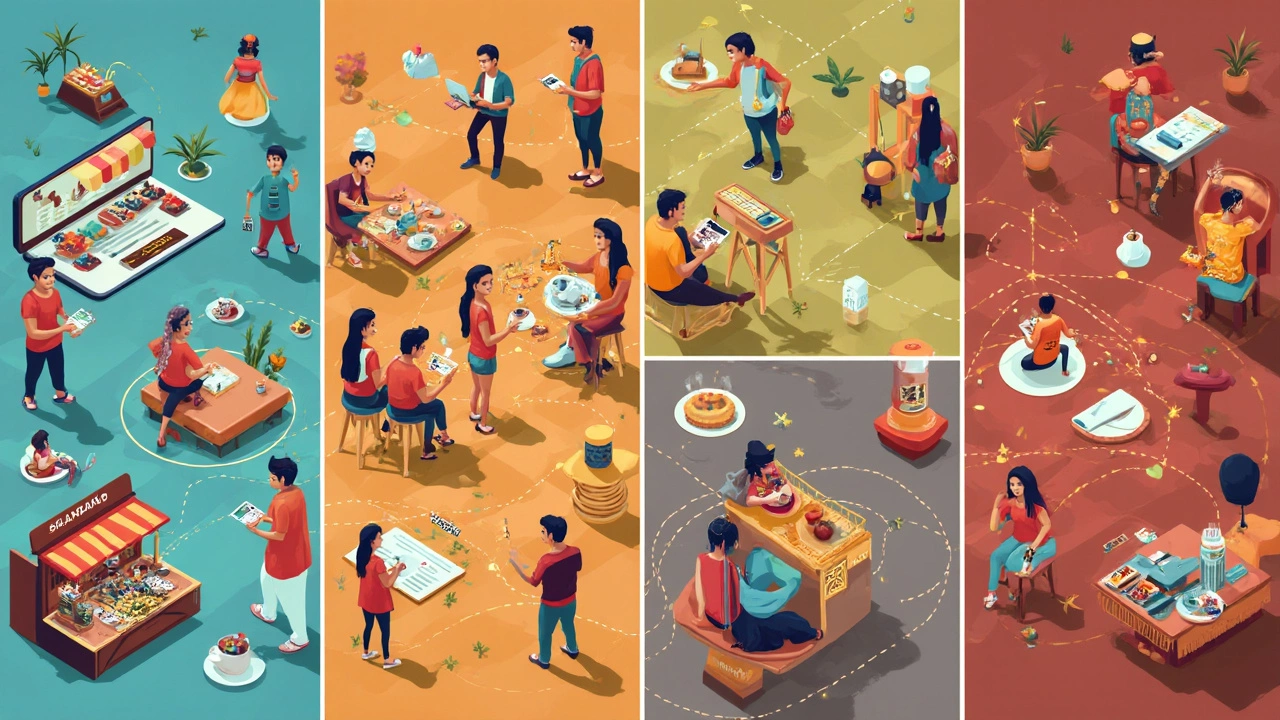Think about your day. Maybe you post a photo, stream a show, order pizza, book a ride, and share a doc with a friend—all without even touching cash or stepping outside. It's wild how many of these actions run through digital platforms, yet few people could name the four main types off the top of their heads. The lines between work, entertainment, shopping, and socializing get blurrier every year, all thanks to these invisible giants working in the background. The more you know about them, the savvier you’ll be—whether you’re browsing, buying, or making your next big move online.
Understanding Digital Platforms: The Big Four
Digital platforms are basically the backbone of modern life, whether you're a business owner, a student, or just someone who can't remember the last time they saw a paper map. But not all platforms are built alike. When you peel back the layers, you’ll keep bumping into these four core types: social media platforms, ecommerce platforms, online search and content platforms, and cloud-based platforms. Each is built for a different purpose and changed the way we live.
Digital platforms are digital spaces or technologies that allow users to interact, transact, or share information. They aren’t just apps—they're infrastructures that connect people, ideas, services, and products. That’s why platforms aren’t only for tech companies anymore. Banks, food delivery, news, gaming—they’re all platforms now, and the better you get at using them, the more power you have over your digital life.
Let’s talk specifics:
- Social media platforms are where conversations, trends, and influence flow. Facebook, Instagram, Twitter, TikTok—these let people, brands, and communities share stories and build connections every minute of the day.
- Ecommerce platforms transform your sofa into a shopping mall. Amazon, eBay, Shopify—they connect buyers and sellers, manage payments, and even handle delivery, all with a few clicks.
- Online search and content platforms help you find what you need, whether that’s the latest news, a tutorial, or a TV show. YouTube, Google, Netflix—if it’s something you want to search, watch, or read, it’s probably here.
- Cloud-based platforms quietly run your apps, store your files, or power multiplayer games, without you worrying about servers. Think Google Drive, Dropbox, AWS, and Microsoft Azure.
Here’s a quick comparison for the numbers nerds:
| Platform Type | Top Example | Monthly Active Users (2024) | What They Do Best |
|---|---|---|---|
| Social Media | 3.05 Billion | Connecting people, sharing content | |
| Ecommerce | Amazon | 2.3 Billion | Online shopping, product discovery |
| Content/Search | 4.3 Billion | Searching information | |
| Cloud-based | Microsoft Azure | N/A (B2B Focused) | Hosting, backup, remote access |
Some platforms, like Google, straddle a couple of categories—they’re both search giants and cloud providers. But thinking about these clear buckets usually makes things easier to follow, especially when you read the next headline about a data breach or a new app going viral.

How the Four Main Digital Platforms Shape Daily Life
Scroll through your feeds, check your email, binge a new series, or search for a recipe—bet you just met three or four different digital platforms before finishing your morning coffee. These platforms are built to hook your attention, make life easier, or both. And the effect? Sometimes subtle, sometimes world-changing.
Take social media first. It’s not just fun, it’s culture. When the Barbie selfie trend hit Instagram and TikTok in 2023, it racked up close to 2 billion mentions in under a month. Movements like #MeToo or 2024’s worldwide climate campaign also spread like wildfire mainly because digital platforms carried them around the globe. These social hubs now help doctors spot health trends, give shoppers personalized ads, and have even swung elections.
Ecommerce is its own universe. When Amazon’s Prime Day rolls out, the site handles more than 300 million products in just 48 hours. Shoppers get more choice and sellers can find markets they’d never reach otherwise. Scammers and counterfeiters lurk in the shadows, so knowing how to check reviews or spot deals that are too good to be true could save you from a headache. Watching payment trends, nearly 60% of online purchases in 2024 happened through digital wallets like Apple Pay or PayPal, not credit cards. That’s a big shift in trust—and risk, too, if you don’t lock down your passwords.
Online search and content platforms are where everyone chases the rabbit holes. Google tallied 99,000 searches per second on average last year. YouTube watched over 500 hours of new video uploaded every minute. Binge culture? Netflix saw the average user spending about two hours per day streaming in early 2024. From viral documentaries exposing real-life scandals to simple 60-second cooking hacks, these platforms have totally re-wired how we learn, distract ourselves, and sometimes even find our next gig.
Cloud-based platforms are less splashy but just as critical. When video meetings and remote school exploded in 2020, cloud servers went into overdrive. By 2024, over 85% of businesses reported relying on cloud platforms for core operations, and even regular folks are storing tens of thousands of photos in the cloud, often without noticing. Files, music, homework, and even medical records sit tucked away in data centers, accessible from anywhere, so long as you remember your login or two-factor code. The catch? Privacy leaks and cyber attacks are the flip side—2023 saw over 2,000 major cloud breaches reported globally.
Some of these platforms are like superhighways, and others are the storefronts or billboards on the side. Knowing who owns them, what data they collect, and how you’re being nudged—by notifications, AI recommendations, even the color of a “Buy Now” button—puts the power back in your hands. Next time you click “accept cookies” without thinking, just remember: you’re never browsing alone. The platform is learning from you, and if you’re clever, you can use it to make life simpler instead of just scrolling away your time.

Making the Most of Digital Platforms: Tips & Future Trends
Here’s the part where you get to play smarter than the average internet user. Platforms keep changing, but a few sharp strategies make a big difference in your daily life and business moves.
- Audit your digital footprint: Search for yourself online, clear out old accounts, and check privacy settings on all your platforms. About 78% of users with open social profiles never review their settings, leaving data ripe for ads...or worse, hackers.
- Stay safe on ecommerce platforms: Look for verified seller badges, read a few reviews before buying, and never wire money outside the official system. Over $10 billion was lost to online scams globally last year, and most people only realized after the cash disappeared.
- Supercharge your searches: Use advanced Google operators (like “site:edu” or “intitle:guide”) to find better results. Also, try privacy-first search engines like DuckDuckGo if you’re tired of the data ad-tracking game.
- Back up everything to the cloud—but not just one cloud: Keep copies of precious files in at least two spots, like Google Drive and an external hard drive, in case a service goes down or you lose access to your login.
Looking towards 2025 and beyond, keep your eye on a few trends. Platforms will mix and merge: social apps will add shopping, while e-commerce sites launch built-in video, reviews, and even AI shopping assistants. Expect more subscription models—monthly fees for everything from music to groceries—and a continued battle over your personal data, as privacy rules catch up to tech giants. Artificial intelligence keeps reshaping recommendations; by the end of 2024, YouTube reported that 85% of videos watched were the result of algorithm suggestions, not searches. Even virtual reality could make a leap, as Facebook (now Meta) pushes its social world into the metaverse, aiming to blend gaming, meetings, and shopping into one giant platform.
The platforms controlling today’s digital world are ruthless innovators. If you’re clued into which type you’re using, you get better at spotting trends early, grabbing business opportunities, protecting your personal info, and just enjoying what’s on offer without falling into traps or endless doom-scrolling. Don’t just be a user—be a digital strategist, even if it’s just for your own life.

